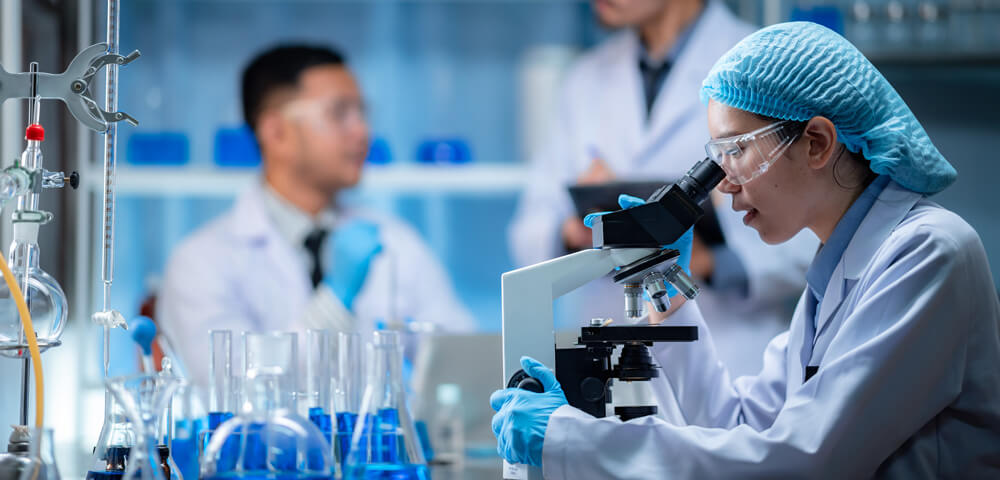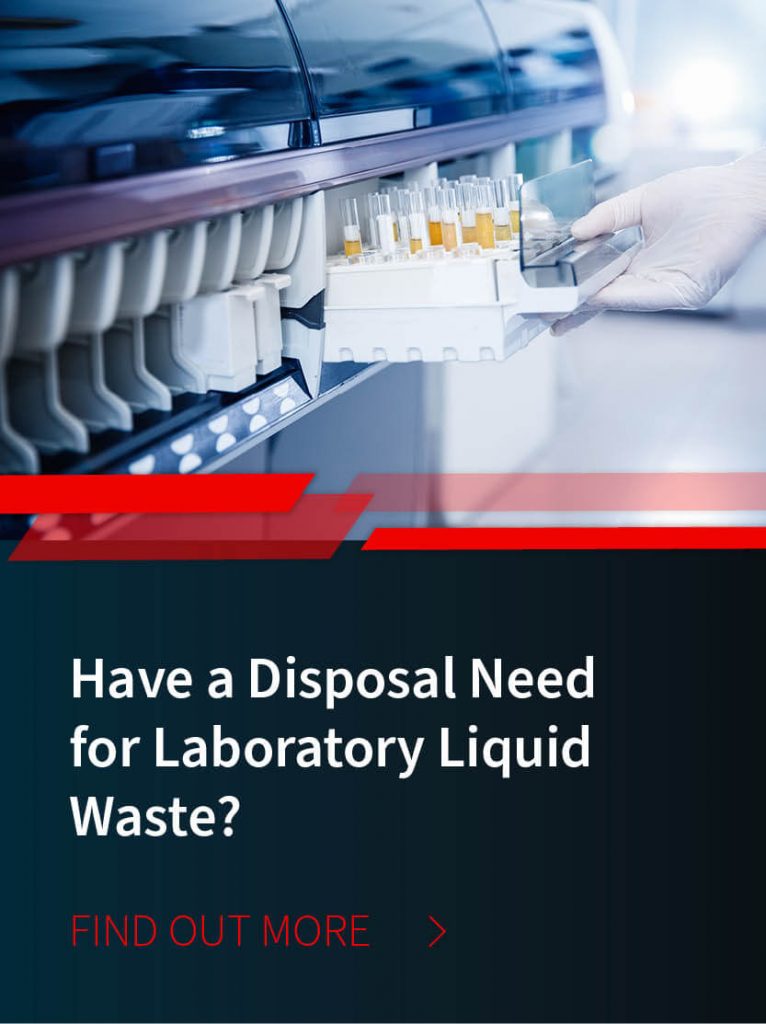
/ IN THIS BLOG
Laboratories are estimated to use 10 times more energy and four times more water than do office spaces, thereby producing a related amount of waste, much of which is hazardous (see source). This blog entry presents and discusses ways by which a laboratory can reduce the amount of hazardous waste it produces. Q&As include:
01 / What are general best practices for managing laboratory waste?
Best practices for managing laboratory waste include but are not limited to
Identifying wastes and separating each into appropriate containers for pharmaceutical, chemical, pathological, and non-hazardous categories
Being careful not to mix hazardous and non-hazardous wastes, so as to avoid spuriously inflating hazardous waste disposal costs
Using approved containers for a particular category of waste. E.g., special tubs, certified cardboard boxes, etc.
Storing containers in a dry and secure area for planned pickup and/or shipping
Labeling and packaging containers per DOT regulations and weight restrictions
Including documentation as required by state and local agencies, DOT, EPA, and OSHA
02 / What is meant by "controlling waste inputs?"
“Controlling inputs” means avoiding the purchase of more than you will likely need of anything that will be considered hazardous when it becomes time to dispose of it, whether it’s spent, used, or unused. Steer clear of bulk purchases, because volume discounts are moot if something you buy expires and must be thrown away before you can use it.
“Controlling inputs” might strike you as uninspired advice. But be mindful that chronic supply‑chain problems being experienced throughout business and industry have engendered a “hoarding mentality” among managers. They don’t want to be caught short. So they’re prone to overbuy.
If it’s obvious that you have more of something than you can feasibly use before its date of expiration, determine if other people, departments, or facilities in your professional network might be able to use it. Also keep in mind that chemicals such as formalin, ethyl alcohol, and xylene are easily recycled.
03 / How do you control waste inputs?
Controlling waste inputs involves understanding what you buy, how you use it, and what amount of it you usually throw away. This will allow you to sharpen your ordering practices to reduce waste consequent to outdating or obsolescence.
For example: assessing preassembled “procedure packs” to see if any included items aren’t used often enough to be in each and every one of them; buying cleaning materials and equipment across departments (instead of for each one) to avoid overbuying; or using washable glassware and instruments instead of disposable ones.
04 / How do you reduce administrative, cleaning, and maintenance waste in laboratories?
Relative to office work:
Encourage email and e-messaging in lieu of paper-and-pencil correspondence.
Use both sides of the sheet when paper-use is unavoidable.
Subscribe to online versions of publications instead of their paper equivalents.
Keep recycling bins handy in conference rooms and kitchens, nearby copy machines, and in high-traffic areas.
Relative to cleaning & maintenance:
Sort cardboard, office paper, and newspapers for recycling.
Use electronic hand-dryers in place of paper towels.
Strategically order cleaning supplies and equipment (see Q.4).
05 / What are the three kinds of hazardous laboratory waste?
There are three common kinds of laboratory hazardous waste: chemical wastes (see Q.6), infectious wastes (see Q.7), and pathological wastes see (see Q.8)—none of which, under penalty of law, should find their way into the municipal waste stream (i.e., down the drain and into the sewer).
06 / What are laboratory chemical wastes?
These are typically chemical wastes from analyzers, calibrators, cleaners, reagents, stains, and test kits. Each of these wastes must be evaluated to determine if it requires hazardous waste disposal per RCRA standards. Also, be mindful that even at scanty levels, the constituents, contaminants, and preservatives found in these wastes might be considered RCRA hazardous.
Examples of chemical wastes in a laboratory might include:
Clinitest tablets (used & unused)
Hemocue Hgb cuvettes
Wright’s stain (used & unused)
Be aware that it’s considered an instance of disposal when you rinse solutions from slides or equipment down the drain. Such solutions must be assayed before they’re rinsed and thereby diluted. Depending on what’s found, you might need to contact your POTW to ensure they’re alright with it. Otherwise, you might be perpetrating an instance of illegal hazardous waste discharge—not good.
All that said, it’s crucial that you get expert advice about your laboratory waste to ensure you’re not inadvertently out-of-compliance in spite of your best efforts, especially because product inserts often neglect to include data concerning small amounts of preservatives and contaminants that require hazardous waste management by the EPA or state-specific lethality laws.
07 / What are laboratory infectious wastes?
These are medical wastes, and not really the focus of this blog entry. But briefly:
Medical wastes are known as biohazardous wastes and called “red bag waste” in hospital and clinical labs. Besides fluid blood or bulk body-fluids and human derived albumin, they include biological agents, attenuated vaccines, cultures, and associated lab detritus that are infectious to humans.
Your lab waste requires hazardous waste disposal if it includes:
Things that have been soaked in blood such as gloves, gauze, and gowns
Infectious disease cultures and/or agents
Discarded pharmaceuticals such as vaccines, antibiotics, pills
Animal or human tissue
Disinfectants and solvents used for lab purposes
Batteries and heavy metals removed from retired lab equipment
Anything or mutagenic, teratogenic, or carcinogenic
You can learn about MCF comprehensive medical waste disposal services here.
08 / What are laboratory pathological wastes?
Again, this is a type of laboratory waste that’s best understood as a category of medical wastes, and really not the focus of this blog entry. These include human tissues and body parts removed by accident, surgery, or autopsy. It also includes carcasses, body parts, and blood derived from research animals.
You can learn about MCF comprehensive medical waste disposal services here.
09 / How are pharmaceutical hazardous wastes classified?
According to the EPA, there are two different kinds of hazardous waste:
Characteristic hazardous wastes have one or more noxious “characteristics.” I.e., corrosivity, ignitability, reactivity, and/or toxicity.
Listed hazardous wastes don’t present such noxious “characteristics” as such. Instead, because they’re byproducts of activities that typically create such hazardous wastes, they’re “listed” as requiring hazardous waste disposal (See Q.10).
10 / What are the EPA "P" and "U" lists?
There are two lists of pure and commercial-grade chemical formulations maintained by the EPA for which the Agency requires hazardous waste management and hazardous waste disposal. These are referred to as the “P” and “U” lists, and they include common drugs such as cyclophosphamide (used to treat leukemia), lindane (scabies), and warfarin (blood clots).
Be mindful that some pharmaceutical products that are neither “characteristic” nor “listed” might anyway be potentially harmful, making hazardous waste disposal prudent to avoid any unforeseen liabilities. These might be:
Formulations containing P- or U-listed drugs
Chemotherapy agents not already listed as RCRA hazardous
11 / Besides chemicals, what else is considered pharmaceutical waste?
Protective clothing and gear, as well as vials, bags, or wipes that contain trace quantities of toxic substances must be properly managed. Ditto for spilled liquids, pills, and packaging.
12 / Where can you get help and advice about laboratory waste?
MCF offers 30+ years of unparalleled experience advising laboratory professionals about managing and reducing their waste streams. We offer comprehensive solutions, products, and services to help you realize the highest standards of sustainability.
Email us today or call 866.315.8116.
Robert Losurdo
President, COO








